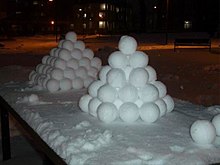Snowball
This article relies largely or entirely on a single source. (April 2015) |

A snowball is a spherical object made from snow, usually created by scooping snow with the hands, and compacting it into a roughly fist-sized ball. The snowball is often used to engage in games, such as snowball fights. Snowball fights are usually light-hearted and involve throwing snowballs at one's friends or family. The pressure exerted by the hands on the snow is a determinant for the final result. Reduced pressure leads to a light and soft snowball. Compacting humid or "packing" snow, by applying a high pressure produces a harder snowball or "iceball", which eventually can be considered harmful during a snowball fight.
A snowball may also be a large ball of snow formed by rolling a smaller snowball on a snow-covered surface. The smaller snowball grows by picking up additional snow as it rolls. The terms "snowball effect", "snowballing" and "Y Gasseg Eira" are named after this process. Often a snowman can be created using this method of snowballing, to create the sections needed to build the sculpture.
There are some temperature and humidity ranges that prohibit or restrict the formation of a snowball. With a powdery snow, snowballs are difficult to form. In temperatures below 0 °C (32 °F), there is little free water in the snow, which leads to crumbly snowballs. At 0 °C (32 °F) or above, melted water in the snow results in a better cohesion. If a person is walking on snow and it squeaks, chances are the conditions are not appropriate for packing snow into a snowball, because squeaking means that the snow is dry.
Self rolling snowballs
Under certain, rarely occurring circumstances, self rolling snowballs form on their own. These circumstances are:
- The ground must have a top layer of ice. This will prevent the snowball from sticking to the ground.
- That ice has to have some wet and loose snow that is near its melting point.
- The wind has to be strong enough to push them. Yet, it cannot be too strong.
- Also, gravity could cause the snowballs to form instead of the wind.
Because these conditions have to take place at the right place in the right time, it is considered a phenomenon.[1]
Beach snow balls
Under other rare circumstances, waves action on ice floes may create beach snowballs.[2] This is the same mechanism that creates rounded boulders and pebbles on a beach.[3]
Literary allusion
A snowball that turns into a child is a protagonist in a 1969 children's novel, The Snowball, by Barbara Sleigh[4]
Gallery
 |
 |
 |
See also
References
- ^ Rare self-rolling giant snow balls found in UK Archived 2010-01-12 at the Wayback Machine, The Telegraph, January 8, 2010
- ^ Emerson, Sarah (8 November 2016). "Thousands of Snowballs on This Siberian Beach Are Straight From a Fairy Tale". Motherboard. Vice Media. Archived from the original on 9 November 2016. Retrieved 8 November 2016.
{{cite news}}: Unknown parameter|deadurl=ignored (|url-status=suggested) (help) - ^ "The coolest beach in America: Hundreds of giant ice boulders weighing 75 POUNDS wash ashore in Michigan". Daily Mail. 28 February 2013. Archived from the original on 11 March 2013. Retrieved 8 November 2016.
{{cite news}}: Unknown parameter|deadurl=ignored (|url-status=suggested) (help) - ^ University of Oxford libraries Retrieved 14 September 2018.
